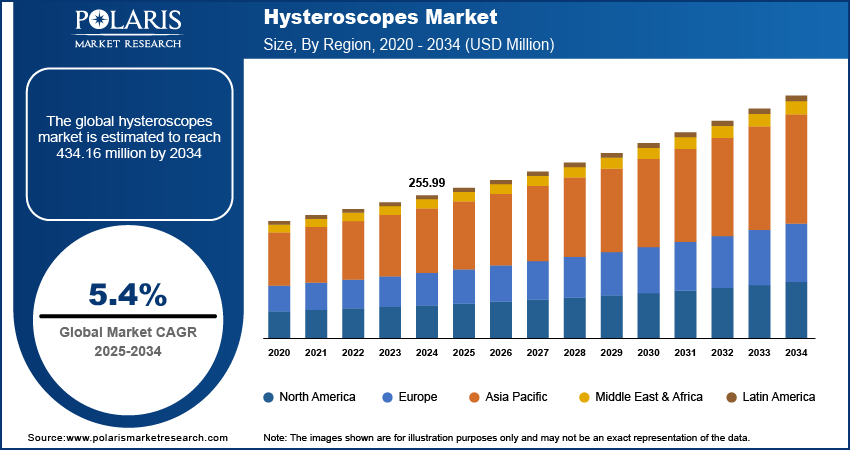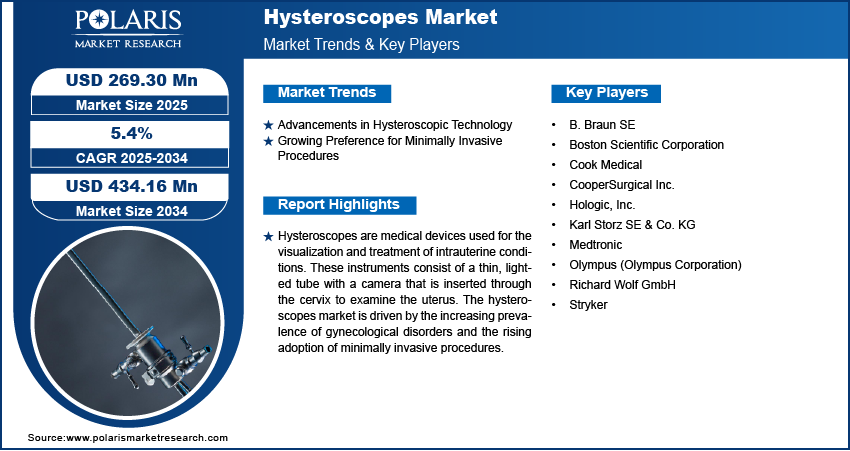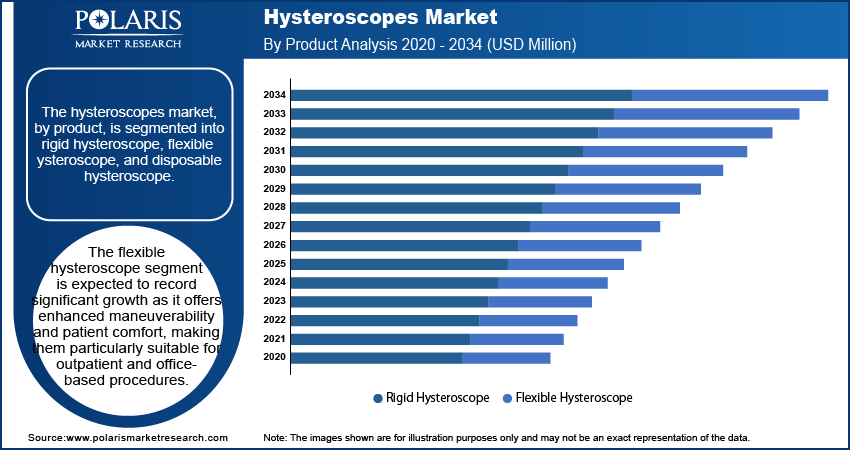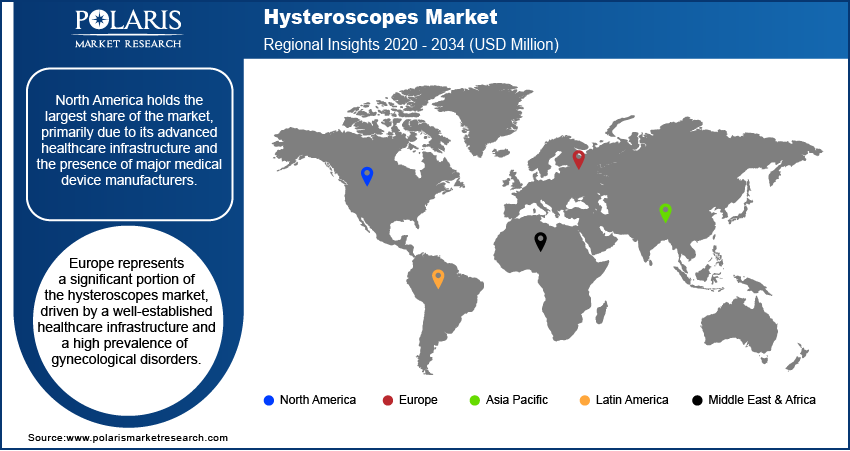
Hysteroscopes Market Size, Share, Trends, Industry Analysis Report
: By Product (Rigid Hysteroscope, Flexible Hysteroscope, and Disposable Hysteroscope), Application, End Use, and Region (North America, Europe, Asia Pacific, Latin America, and Middle East & Africa) – Market Forecast, 2025–2034
- Published Date:Apr-2025
- Pages: 118
- Format: PDF
- Report ID: PM3431
- Base Year: 2024
- Historical Data: 2020-2023
Hysteroscopes Market Overview
The global hysteroscopes market size was valued at USD 255.99 million in 2024. The market is projected to grow from USD 269.30 million in 2025 to USD 434.16 million by 2034, exhibiting a CAGR of 5.4% during 2025–2034.
The hysteroscopes market is driven by the increasing prevalence of gynecological disorders, rising adoption of minimally invasive procedures, and advancements in hysteroscopic technology. Hysteroscopy is widely used for diagnostic and operative procedures, including endometrial polyp removal, fibroid resection, and intrauterine adhesiolysis, which contributes to market growth. The demand for hysteroscopes is further supported by the growing awareness of women’s health and the rising preference for outpatient procedures, reducing hospital stays and overall healthcare costs. Additionally, technological advancements, such as the development of single-use hysteroscopes and improved imaging systems, are enhancing procedural efficiency and expanding adoption.
Qualitative analysis of the hysteroscopes market indicates a shift toward disposable and office-based hysteroscopy, reducing the risk of cross-contamination and enhancing patient convenience. The increasing focus on cost-effective treatment options and improved reimbursement policies are supporting market expansion. Emerging markets present significant opportunities due to improving healthcare infrastructure and increasing investments in women’s health. The market is expected to witness continued growth, driven by innovations in hysteroscopic devices and the rising demand for minimally invasive gynecological procedures.

To Understand More About this Research: Request a Free Sample Report
Hysteroscopes Market Dynamics
Advancements in Hysteroscopic Technology
Technological innovations have markedly improved the capabilities and applications of hysteroscopes, fostering increased adoption in clinical practice. The development of high-definition imaging systems and miniaturized, flexible hysteroscopes has improved diagnostic accuracy and patient comfort along with efficiency in uterine fibroid treatment. A study published by the National Center for Biotechnology Information (NCBI) in December 2023 highlighted the potential of an AI-driven algorithm in diagnosing uterine fibroids based on MRI scans, which could enhance the effectiveness of hysteroscopic procedures. These advancements not only streamline hysteroscopic interventions but also expand their utility in outpatient and office-based settings, making them more accessible and efficient for both patients and healthcare providers, thereby propelling the hysteroscopes market revenue.
Growing Preference for Minimally Invasive Procedures
There is a notable shift towards minimally invasive surgical techniques in gynecology, driven by benefits such as reduced recovery times, decreased postoperative pain, and lower complication rates. Hysteroscopy, as a minimally invasive procedure, aligns with this trend by offering a less intrusive option for diagnosing and treating intrauterine pathologies. The Centers for Disease Control and Prevention (CDC) reported in June 2023 that approximately 11,500 new cases of cervical cancer are diagnosed annually in the US, with around 4,000 resultant deaths. This underscores the growing demand for effective diagnostic and therapeutic tools like hysteroscopes, which facilitate early detection and treatment of such conditions, thereby improving patient outcomes and aligning with the broader healthcare objective of promoting less invasive medical interventions.

Hysteroscopes Market Segment Insights
Hysteroscopes Market Assessment by Product Insights
The hysteroscopes market, by product, is segmented into rigid hysteroscope, flexible hysteroscope, and disposable hysteroscope. The flexible hysteroscope segment is expected to experience significant growth within the hysteroscopes market. Flexible hysteroscopes offer enhanced maneuverability and patient comfort, making them particularly suitable for outpatient and office-based procedures. Their ability to navigate the uterine cavity with minimal discomfort has led to increased adoption in clinical settings focused on patient-centered care. The rising demand for minimally invasive diagnostic and therapeutic procedures contributes to the expansion of the flexible hysteroscope segment. Ongoing innovations, such as improved imaging quality and the development of disposable flexible hysteroscopes, are expected to further propel the growth of this segment.
Hysteroscopes Market Evaluation by Application Insights
The hysteroscopes market, by application, is segmented into myomectomy, polypectomy, endometrial ablation, and others. The endometrial ablation segment dominated the market in 2024. Endometrial ablation, a procedure designed to destroy the uterine lining to treat abnormal uterine bleeding, is gaining traction due to its minimally invasive nature and high success rates. The increasing incidence of menorrhagia and patient preference for less invasive treatment options are driving the demand for hysteroscopic endometrial ablation. Innovations in ablation technologies, such as the development of advanced energy delivery systems, have enhanced procedural efficiency and patient safety. The shift towards outpatient settings for performing endometrial ablation further contributes to the segment's leading position, as it offers cost-effective solutions and greater convenience for patients.

Hysteroscopes Market Regional Analysis
By region, the study provides the hysteroscopes market insights into North America, Europe, Asia Pacific, Latin America, and the Middle East & Africa. North America holds the largest share in the market, primarily due to its advanced healthcare infrastructure and the presence of major medical device manufacturers. The region's well-established healthcare facilities enable the adoption of advanced hysteroscopic technologies, facilitating early diagnosis and treatment of gynecological conditions. Additionally, heightened awareness of women's health issues and favorable reimbursement policies contribute to the widespread utilization of hysteroscopic procedures. The strong focus on research and development further propels the market, leading to continuous innovations and improved patient outcomes.
Europe represents a significant portion of the hysteroscopes market, driven by a well-established healthcare infrastructure and a high prevalence of gynecological disorders. The region's focus on women's health has led to increased adoption of advanced hysteroscopic procedures for both diagnostic and therapeutic purposes. Countries such as Germany, France, and the UK are at the forefront, with substantial investments in medical technology and continuous efforts to enhance patient care. The presence of major industry players and favorable reimbursement policies further support the market growth in this region.
Asia Pacific is experiencing rapid growth in the hysteroscopes market, attributed to improving healthcare infrastructure and rising awareness of minimally invasive surgical options. Countries like China, Japan, and India are witnessing an increase in the adoption of hysteroscopic procedures, driven by a large patient population and a growing focus on women's health. Government initiatives aimed at modernizing healthcare facilities and increasing investments by key market players are also contributing to the hysteroscopic market expansion in Asia Pacific.

Hysteroscopes Market – Key Players and Competitive Insights
The hysteroscope market features several prominent companies actively contributing to its growth and innovation. These key players include B. Braun SE; Boston Scientific Corporation; Cook Medical; CooperSurgical Inc.; Hologic, Inc.; Karl Storz SE & Co. KG; Medtronic; Olympus (Olympus Corporation); Richard Wolf GmbH; and Stryker.
These companies are recognized for their significant contributions to the hysteroscope market, offering a range of products and solutions that cater to various medical needs. Their active participation and continuous innovation play a crucial role in advancing the field of hysteroscopy.
Olympus Corporation is a global medical technology company specializing in designing and delivering advanced optical and digital solutions for medical applications. Their product portfolio includes a range of hysteroscopy systems, such as the 8.5 MM Hystero-Resectoscope featuring plasma hysteroscopic resection and vaporization electrodes, and the VERSAPOINT II Bipolar Electrosurgery System. These instruments are utilized in gynecological procedures to diagnose and treat intrauterine conditions. Olympus is committed to enhancing women's health by providing innovative tools that improve diagnostic accuracy and therapeutic outcomes.
Stryker Corporation is a prominent player in the medical technology sector, offering a diverse array of products and services across various medical specialties. While Stryker's portfolio encompasses numerous medical devices, its involvement in the hysteroscopes market is complemented by its strategic acquisitions and product innovations. The company's focus on expanding its medical device offerings aligns with its mission to improve healthcare outcomes through advanced technology and comprehensive solutions.
List of Key Companies in Hysteroscopes Market
- B. Braun SE
- Boston Scientific Corporation
- Cook Medical
- CooperSurgical Inc.
- Hologic, Inc.
- Karl Storz SE & Co. KG
- Medtronic
- Olympus (Olympus Corporation)
- Richard Wolf GmbH
- Stryker
Hysteroscopes Industry Developments
- November 2024: Olympus Corporation showcased its broad range of gynecological solutions at the AAGL World Congress, highlighting innovative products and eLearning offerings in gynecological care.
- July 2024: Meditrina received FDA clearance for its Gen 2 bipolar RF hysteroscopy system and Aveta Glo bipolar RF device, advancing minimally invasive gynecological procedures with enhanced efficiency and control.
Hysteroscopes Market Segmentation
By Product Outlook (Revenue – USD Million, 2020–2034)
- Rigid Hysteroscope
- Flexible Hysteroscope
- Disposable Hysteroscope
By Application Outlook (Revenue – USD Million, 2020–2034)
- Myomectomy
- Polypectomy
- Endometrial Ablation
- Others
By End Use Outlook (Revenue – USD Million, 2020–2034)
- Hospitals
- Ambulatory Surgical Centers
- Gynecology Clinics
- Others
By Regional Outlook (Revenue – USD Million, 2020–2034)
- North America
- US
- Canada
- Europe
- Germany
- France
- UK
- Italy
- Spain
- Netherlands
- Russia
- Rest f Europe
- Asia Pacific
- China
- Japan
- India
- Malaysia
- Suth Korea
- Indnesia
- Australia
- Vietnam
- Rest f Asia Pacific
- Middle East & Africa
- Saudi Arabia
- UAE
- Israel
- Suth Africa
- Rest f Middle East & Africa
- Latin America
- Mexic
- Brazil
- Argentina
- Rest f Latin America
Hysteroscopes Market Report Scope
|
Report Attributes |
Details |
|
Market Size Value in 2024 |
USD 255.99 million |
|
Market Size Value in 2025 |
USD 269.30 million |
|
Revenue Forecast by 2034 |
USD 434.16 million |
|
CAGR |
5.4% from 2025 to 2034 |
|
Base Year |
2024 |
|
Historical Data |
2020–2023 |
|
Forecast Period |
2025–2034 |
|
Quantitative Units |
Revenue in USD million and CAGR from 2025 to 2034 |
|
Report Coverage |
Revenue Forecast, Market Competitive Landscape, Growth Factors, and Industry Trends |
|
Segments Covered |
|
|
Regional Scope |
|
|
Competitive Landscape |
|
|
Report Format |
|
|
Customization |
Report customization as per your requirements with respect to countries, regions, and segmentation. |
FAQ's
The hysteroscopes market size was valued at USD 255.99 million in 2024 and is projected to grow to USD 434.16 million by 2034.
The market is projected to register a CAGR of 5.4% during the forecast period.
North America had the largest share of the market in 2024.
A few of the key players in the market include B. Braun SE; Boston Scientific Corporation; Cook Medical; CooperSurgical Inc.; Hologic, Inc.; Karl Storz SE & Co. KG; Medtronic; Olympus (Olympus Corporation); Richard Wolf GmbH; and Stryker.
The endometrial ablation segment accounted for the larger share of the market in 2024.
The flexible hysteroscope segment is expected to experience significant growth within the market.
